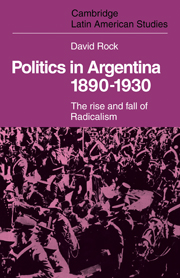Book contents
- Frontmatter
- Contents
- Preface
- 1 The components of Argentine society, 1890–1914
- 2 The oligarchy and institutional reform, 1880–1916
- 3 The rise of Radicalism, 1891–1916
- 4 The workers and their politics in Buenos Aires, 1890–1916
- 5 The first Radical government, 1916–22
- 6 The strikes, 1916–18
- 7 The Semana Trágica
- 8 1919
- 9 Postscript to the first presidency, 1920–2
- 10 The Alvear interlude, 1922–8
- 11 Yrigoyen's second presidency, 1928–30
- 12 Perspectives
- APPENDIXES
- 1 The occupational and class structure of the male population of the city of Buenos Aires by nationality, 1914
- 2 The rise of Radicalism – an historiographical note
- 3 The first Radical government and the Argentine Rural Society
- 4 The working class vote for the Radical and yrigoyenista parties in selected areas of Buenos Aires, 1912–30
- Select bibliography
- Index
- Frontmatter
- Contents
- Preface
- 1 The components of Argentine society, 1890–1914
- 2 The oligarchy and institutional reform, 1880–1916
- 3 The rise of Radicalism, 1891–1916
- 4 The workers and their politics in Buenos Aires, 1890–1916
- 5 The first Radical government, 1916–22
- 6 The strikes, 1916–18
- 7 The Semana Trágica
- 8 1919
- 9 Postscript to the first presidency, 1920–2
- 10 The Alvear interlude, 1922–8
- 11 Yrigoyen's second presidency, 1928–30
- 12 Perspectives
- APPENDIXES
- 1 The occupational and class structure of the male population of the city of Buenos Aires by nationality, 1914
- 2 The rise of Radicalism – an historiographical note
- 3 The first Radical government and the Argentine Rural Society
- 4 The working class vote for the Radical and yrigoyenista parties in selected areas of Buenos Aires, 1912–30
- Select bibliography
- Index
Summary
During the first half of 1919 the tensions between the government and the conservative elite over the strike question produced a number of complex situations in which two major political crises can be discerned. These called into question the whole scheme of representative government introduced by the Sáenz Peña Law in 1912. They brought to a head the issue of the real location of political power, and in doing so they further exposed the weak objective supports for the changes Yrigoyen had tried to implement. For the first time the armed forces were brought directly into politics as arbiters over the fate of a civil administration. Also 1919 saw the emergence of a new popular alliance, the Argentine Patriotic League. This, if not directly or openly antagonistic to Radicalism, was controlled by the conservative elite groups, and in a position to exercise decisive leverage over the government.
On several occasions in 1919 the Radical government was forced to struggle desperately for survival. It finally managed to do so, though it was compelled to abandon the genuinely progressive aspects of its policies. Increasingly, on a whole series of fronts, and most notably in its relations with foreign capital, it was coerced into returning to the established moulds of the past. By the end of the year its attempt to change the position of the unions had almost entirely collapsed. Finally, the government was compelled to make a number of major readjustments to its techniques for dealing with the mass electorate.
- Type
- Chapter
- Information
- Politics in Argentina, 1890–1930The Rise and Fall of Radicalism, pp. 157 - 179Publisher: Cambridge University PressPrint publication year: 1975
- 1
- Cited by

